#5 seasons being when the moon rune lighting up is putting them in danger
Text
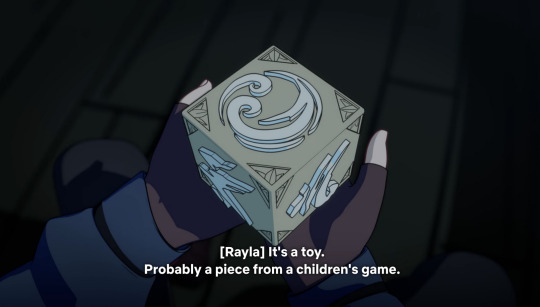
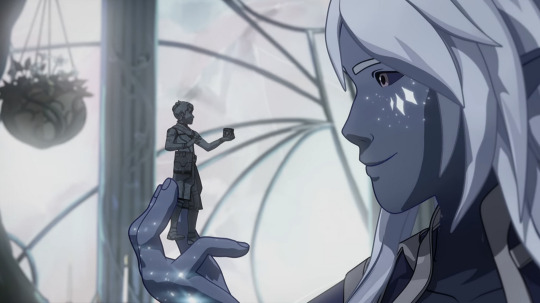







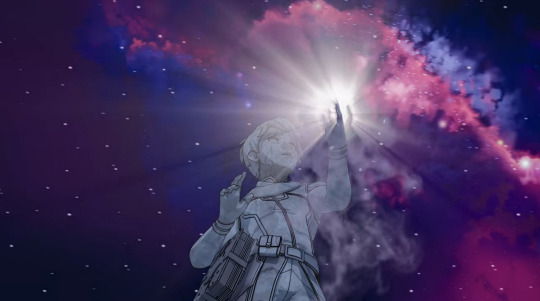






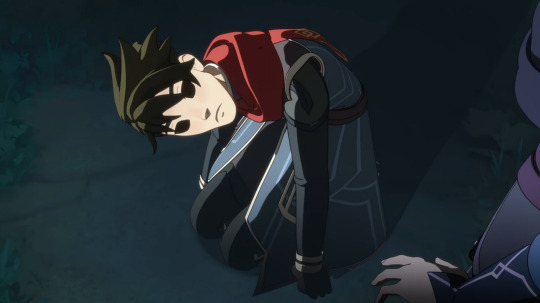








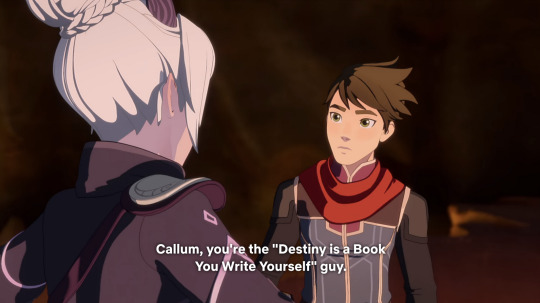
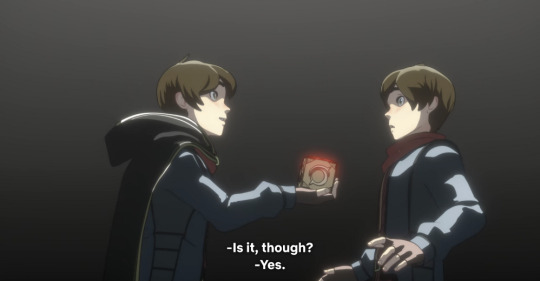



This is the game room. The cube should be in there. [...] That door's locked. So you wait a minute, maybe two minutes, however long it takes, I'll go find a key.
#the dragon prince#the key of aaravos#devil and the lovers#cube hostage exchange theory#it's the way i almost cried making this and how you know i'm So Normal about it#+ ezran for once hi ezran!!#ezran's one line (pointed out by leethee) regarding the key in#5 seasons being when the moon rune lighting up is putting them in danger#and for callum to put it away. yeah. Yeah#the conspiracy hat fits well tonight lads#+ variants at this point#foreshadowing#parallels#arc 1#arc 2#both 4x04 & 5x08 ultimately having the pawn intro bc callum is compromised. bc of dark magic#bc of a loss of control
70 notes
·
View notes
Text
Books I Read in 2024, #6: Runequest: Roleplaying in Glorantha (Greg Stafford Steve Perrin Jeff Richard Jason Durall and friends, Chaosium Inc., 2019)
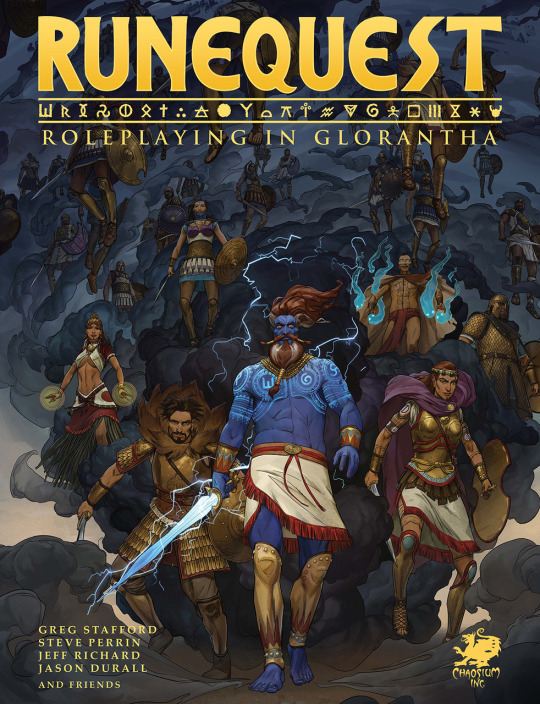
A bronze age-styled fantasy epic setting originally published in 1975 (as White Bear and Red Moon), Glorantha is one of the founding touchstones of fantasy storytelling in the RPG space that draws upon historiography and a firm integration of magic and mysticism into the firmament of its setting.
My first experience with Glorantha, like a great deal of others, was King of Dragon Pass. I don't remember exactly where I first heard about it. It's either on SA in the LP subforum back in the early 2010s or Tumblr in the same era; if it's the latter, Jared is entirely to blame for this, and probably because of him telling me stories about it in my car over the years.
King of Dragon Pass is a management game in which you play the tribal leader of a Heortling group exiled from their homeland in the wake of Belintar's accession to the throne in the Holy Country of Esrolia, forced to travel to the forbidden land of Dragon Pass where centuries ago the Dragonkill War wiped the land clean of all human presence. For you see, the Dragonkill War was named not for what we did to the dragons, but what dragons did to humanity.
Glorantha is like that.
Glorantha sticks in my mind easily, to be honest. It draws such a stark picture of itself so quickly you can't help but feel arrested by how committed it is to being itself. The Gods are so real that reenacting their greatest deeds invests you with their awe-inspiring power, and the Runes they wield are so bound into the fundament that embodying and studying them allows you to manipulate reality directly yourself.
The game itself is straightforward; every skill is rated from 0 to 100, and you roll 2d10 to roll under your skill rating, which you can further influence by channeling your passions or the Runes that represent you. Its character creation is delightfully baroque and fitting with the focus on historiography: you roll to generate the general lifepath of your parents and your own history in the last 21 years of Dragon Pass' history, during an eventful lead-up to the Hero Wars starting in 1625 when the world will enter a true tumult as empires face off.
I really just love the little things about the world here. Glorantha is detailed in the way that only a seasoned reader of history would be, with a light touch to give you plenty of room to imagine your own tribes in the region, the foibles of each village that give it real texture. The book grounds you in the idea of being from each ethnic group, the stereotypes others hold for them and the realities of their lives.
More than once it states that the Orlanthi recognize 6 gender roles and 7 forms of marriage, which is both a refreshing acknowledgement and also just a good reminder that societies for centuries have seen things in ways that would be foreign to the modern reader, and that you have to think of these societies in the context they've been shaped by.
The various pantheons of the world rule. I could evangelize about Orlanth, the god of storms all day, but it rules that the chief god of the largest and best-known pantheon, the Lightbringers, is the god of the season of utter disaster where life becomes cheap and dangerous, which i suppose makes sense as far as who you would beg to for survival during.
It's combat is dangerously swingy, in a way that kind of rules, in that you can plan for a lot of bad things to happen but you really can't stop that 5% roll from putting a javelin through your soft palate. This is your granddaddy's RPG, there's no luck recovery methods. You die, you beg the local priest for a resurrection and pay him handsomely for the privilege and don't do that shit again.
It just sticks in the mind for me. Very few other RPGs take the sort of careful, historically and culturally-focused bent on producing and placing a world in the way that Glorantha does. It feels lived in and loved, with a clear idea of itself and what it wants to be. I wish I could say the same for more games in the space.
20 notes
·
View notes
Text
My Journey
At the tender age of thirty-five, I have discovered anime. Don’t get me wrong, I first watched Princess Mononoke at sixteen. It was my first exposure to Eastern thought, and it blew my tiny adolescent western mind, and I loved it. But outside of Ghibli movies and Voltron (which I don’t count), I’ve never sought it out on my own.
As a previous post might indicate, I am obsessed with Godzilla, so it isn’t as if I’m closed off from Japanese media. Most of the video games I play are Japanese. (Fire Emblem, Harvest Moon, Rune Factory, pretty much anything Nintendo.) One of my partners is even a Pacific Islander of Japanese descent, who lived in Japan, who speaks Japanese. And we’ve been together seven years. But all of the sudden, now I’m on this quest to make up for lost time and consume all the anime I can.
(Note: If you have suggestions, I would love them. But I would prefer if they were queer. I want women in love with other women. It doesn’t have to be overt, but I don’t want any heterosexual romances, and would prefer as few male characters as possible. I’ve seen enough male-driven storylines, thanks.)
But today, I am here to word-vomit all about the queer extravaganza that is Senki Zesshou Symphogear. Because I am addicted. I’ll start with this picture.

And so begins our journey...
The show starts out the gate being super gay. Tsubasa (Blue) and Kanade (Red) are each a half of the singing duo Zwei Wing. They refer to one another as partners and there is a lot of “We can do anything as long as we’re together” and “I’m going to sing with you forever” type stuff.
Then there is Hibiki and Miku:
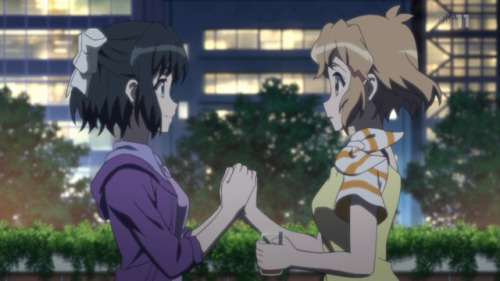
Friends since childhood, they are the core couple of the show. Hibiki is the main character who typically discovers she’s not just a normal girl and has the ability to wield a Gear, which allows her to become this adorable badass superhero. Miku is her anchor in the mundane world. She is frequently the one person or thing that can reach/inspire/motivate Hibiki. She is what drives Hibiki.
Hibiki calls Miku her sunflower, the place where she is warmest, where she will always return to.
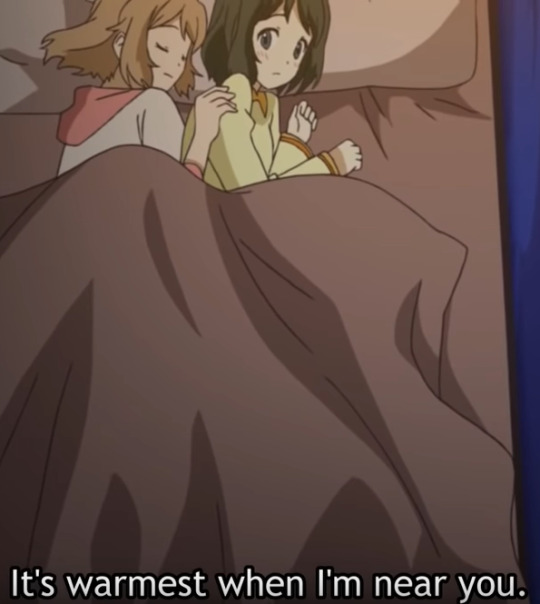
Which brings me to the point that they share a bed. Despite having bunk beds, they always sleep together. Except when they’re fighting, then they go to their respective bunks. It’s just so cute.
The characters are delightfully complex. Hibiki is as pure as the driven snow but she isn’t naive. Usually, pure characters are oblivious or ignorant to the danger or evil around them, but Hibiki isn’t. She knows fighting is dangerous. She knows people can be evil, but those things never deter her. It makes her incredibly brave, even when confronted with someone she knows is malicious, she extends her hand in friendship because she chooses to believe the best in others. It is nice to see a character who is sweet and pure without being an utter dumbass.
We’ve all seen it. The sweet, precious hero is surprised that the bad guy who has been trying to kill them for an entire season won’t be their friend. Hibiki is NOT like that. She always gives people the opportunity for kindness without expectation, with the full awareness that it might be rejected.
Miku is the sweet, somewhat demure, nurturing one. She is the caretaker character. You might initially think she’s the standard timid and meek best friend stock character. But nope. She does not suffer fools. She is not an enabler. She is not afraid to call anybody out on their bullshit, regardless of who they are. She does what she thinks is right which also makes her very brave. She wants to protect Hibiki as much as Hibiki protects her.
Their dynamic is just lovely. Hibiki can kind of be a mess sometimes. She’s absent-minded, never on time, doesn’t prioritize school work. Miku is always there to pull her back down to earth, to center her. If she feels Hibiki is losing focus or deviating from who she is, Miku will always be the one to ground her. She truly is Hibiki’s anchor, her safe place. And I love it.
Oh and there is my dear Yukine Chris. I won’t go super in detail, but I will leave you with this:

It is exactly what it looks like. A queer D/s relationship. Unfortunately, it’s toxic and unhealthy. A whole lot of “I’m the only one that can love you” and “You have to obey me or I won’t love you anymore” and “I’m angry so you have to let me take it out on you” and so on. It’s all taken directly from the Abusive Relationship Handbook.
But worry not, we are not subjected to the toxicity for terribly long, and Chris gets the kindness and love she deserves from her new friends and senpai. I’d go more in depth, but y’know... spoilers.
Now, let us march forward to season two where our Roster of Queerness is completed by three additional characters. Two of which are so cute I cannot even fucking stand it.
I call them my Precious Gay Babies.

Kirika and Shirabe are two little baby gays that grew up in an orphanage with only one another and Maria, who is like a big sister to them. But oh my fucking god they are so precious I can’t even handle it.

Kirika is the more animated of the two. The sweet, cheerful ray of sunshine. And Shirabe is the quieter, more solemn of the two. They literally have a fight where they are shouting back and forth at each other how much they love one another. If this show was only about them, I would watch it. They are just way too cute.
Shirabe can be a little possessive of Kirika, and Kirika knows who she belongs to. If another girl touches her, she knows Shirabe will put the stomp down on it. I usually find behavior like that kind of squicky and toxic, but in this instance it isn’t too gross because I think it’s rooted in their background. They’ve only ever had one another so they’re extremely protective of each other.
I mean, just look.

Look at my Precious Gay Babies!

LOOK AT THEM!!
They are so cute and precious and I love them.
Let me wrap this up with Maria.
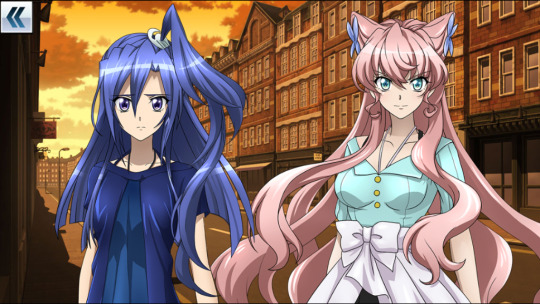
I won’t go too in depth with Maria because I don’t want to be spoiler-y. But 1) She’s fantastic. 2) No, I don’t know what’s up with her hair. 3) She is totally queer for Tsubasa, and I’m sailing on that ship.

I am midway through the fourth season. So, I haven’t caught up to the most current season (5) but holy hell. I am invested.
It’s just a bunch of girls (oh! And there is even a genderless, sexless character who is precious and I love) being in love with other girls and fighting monster things.
I fucking love this show. Right now, it’s kind of vying for top spot with Valkyrie Drive: Mermaid. Which may only be my number one because it’s a little more overt in its women sleeping with other women thing. It’s equal parts “fuck yes!” combined with “am I high right now?” That’ll be my next post, I digress.
If you are in the mood for some light but surprisingly good entertainment featuring a strong line of female characters who all fall in love with one another, then I cannot recommend Senki Zesshou Symphogear enough. It is fan-fucking-tastic. It doesn’t require too much thought, but it makes up for it by giving you a ton of warm, fuzzy feels.
And if you can recommend me anything similar. Or anything that heavily features queer women, I would be forever in your debt.
Oh, and PS there is a mobile game, which is how I found the show in the first place. Downloaded the game, played it, then got all fucked up on the anime. Worth it.
#symphogear#senki zesshou#tachibana hibiki#hibiki#miku kohinata#yukine chris#kirika akatsuki#maria cadenzavna eve#tsubasa kazanari#shirabe x kirika#amou kanade#zwei wing#hibiki x miku#precious gay babies
66 notes
·
View notes
Text
self promo meme
Rules: Post the first line of your last 10 published fics, then tag 10 people.
I was tagged, I can’t find by who but I’m doing it. So, here we go:
1- Surrounded by Fire : Rating: Mature (for future chapters) Still in progress= Kyrie growled as she glared into the darkness, feeling the presence of suppressive energies. “Will no one tell me why I am here? Or why I am being treated like a common thug?” Gathering her strength, she rose to her knees. “Cowards. Templar filth.”
2- Relief : Rating: Mature (for later chapters) still in progress = He’d been to several doctors, all of them telling him his near blinding nerve pain and aches would pass in time. Lyrium was a hell of a withdrawal. If it wasn’t the insomnia keeping him up at all hours, it was the anxiety it brought with it.
3- Just In Time : Rating: Mature FINISHED = Folding the egg whites into his flour mixture Cullen dabbed at his forehead, smearing a line of white powder along the way. Jessica’s school bake sale was tomorrow and between shopping in the chaos that was the holiday season and keeping his precious little angel out of the kitchen, he was sweating to death.
4- I Ain’t Afraid of No Ghost : Rating: Mature FINISHED = Diana lay soaking in her oversized bath, content from a long journey back to Haven. After clearing out the Fallow Mire location and rescuing the Inquisition agents, Josephine had arranged a private bath in her quarters.
5- It’s Only Words - Rating: NSFW FINISHED = He didn’t know why he was putting words to paper but with quill firmly in hand he was powerless to stop the flow of words.
6- Sleep - Raiting: Mature FINISHED = After traveling for nearly a month you can see the lights from Skyhold. Sighing heavily, you were near desperate to get to you chambers. Inside, the enchanted tub would be filled with fresh water, waiting for you to activate the heat rune Dagna had imbued into it.
7- Heart’s Assassin : Rating: Mature/NSFW FINISHED = Fawynn Surana was in the process of folding her robes away to head down to the stream and bathe. Something she had learned to enjoy. It wasn’t the same old wash tubs the Circle had but it had a perk she never knew she missed; stars. Thousands and thousands of glittering orbs that twinkled above her when she relaxed in the warm water.
8- Bound to Please: Rating: VERY VERY VERY NSFW FINISHED = He wanted to, had been wanting to for a while. Cullen didn’t want to admit that he had his kinks, his little dark pleasures and fantasies.
9: Must Have Been the Wine : Rating: Mature fluff FINISHED = You’ve been trying for weeks to garner his attention, but every time you seem to make progress, something pops up. You knew he was something incredible when you first laid eyes on him at Haven, but shell shock, and a myriad of tasks kept you apart.
10: Dark Moon Tempest: Rating: Mature FINISHED = Kiera Cutter groaned rolling out of bed. It was already late in the morning and she was dangerously close to being late for work, “I’ve got enough time.”
I see a predictable pattern in my style and I’m alright with that. I like to drop my reader into the middle of the action or scene and run from there. It works for me and I think it flows well.
Hit me up if you want to chat about any of the fics above. My ask is always open, annon is on. I am tagging anyone who wants to do it. Please, pump yourself up and put your work out there! You are worthy!!!
Cheers lovelies, more to come soon. Promise.
6 notes
·
View notes
Text
The Hunger of the Sands Pantheon
This campaign has its own pantheon. However, the campaign starts in a setting where there are no gods. Any mentions of gods are treated as fairy tales or something only children would believe in. (fairy tale gods arent from an actual pantheon its more that people see the mention of godlike beings to be similar to say a unicorn in our world). Thousands of years ago, there used to be a full pantheon. These gods were killed off during a god war and all records of their existence was destroyed over time.
1. Anathel – known for being the first and most powerful of the pantheon. She is the goddess of the sun, light/life, and tides and is depicted as the protector of sailors. ��There are recordings of her creating safe passages for sailors caught up in storms, whether it be by parting the clouds themselves so that the sun can reach them, or calming the waves themselves. There are also recordings of her bringing random objects to life in order to delight those around her. She was also known as the winged-one, the sun, and the shining-one. Everyone paid tribute to her in some way, even if she wasn’t their preferred god. Her symbol is a circle of waves with a sun in the center.
2. Anathel’s Shadow – known for always being with Anathel. As the light grows, so too does her shadow. Anathel is never without her shadow and thus her shadow knows everything that she knows. As Anathel is light itself, wherever light is cast, her shadow there as well. Anathel’s shadow is known for hearing and seeing everything, especially secrets. Those who wished for their secrets to be kept would often leave offerings in the darkest portions of the room. Those who were clerics of Anathel knew that her shadow was different from regular darkness. They honored this distinction by lighting a candle and leaving offerings in the shadow cast or by only leaving offerings in shadows cast by the sun. Anathel’s Shadow does not have a symbol, but some used two white triangles facing downward with two black triangles mirroring them to represent her shadow.
3. The Builder – known for being humble and preferring to work alongside the common man. The Builder was the second god to be born and the closest to Anathel. He is the god of building, creation, and success. People would pray to him for success in any activity, especially building or trades. He was said to reward anyone willing to work hard towards their goals. In the creation tales, The Builder would build creatures and Anathel would bring them to life. The first creature he made was a turtle, so his symbol is a turtle shell.
4. Effrie – known for her youth. Effrie is a young goddess that is both carefree and fickle. Depictions of her always showed her hair as long and flowing in the air behind her. She is the goddess of winds and the sky. One moment, she will grace you with winds, and the next she is bringing tornadoes down upon the land. People would pray to her during particularly hot seasons for cool breezes or to calm the skies during storms. Effrie had a love for flowers, especially flower crowns, and children. Children who prayed while wearing flower crowns would often have their wishes granted before having a breeze come and pluck the crown off of their heads, before disappearing into the sky. Her symbol is three spirals symbolizing breezes.
5. Selica – known for her body that is “shaped like a tear drop”. Selica is the goddess of water, rain, and typhoons. Many depictions of her are solemn with her sitting with her legs folded and staring down at her hands in her lap. However, just as the sea is known as being both bountiful and dangerous, Selica was the same. Depictions of her were solemn and calm, but those who lived by the sea and worshipped her knew better. The water goddess had a feisty side and it was best not to get on her bad side, lest she bare her teeth at you. Her symbol is a drop of water leading to a stream that is wrapped into a circle.
6. Roarn – also known as “rowdy boy” by Resa. Roarn is the god of beasts, nature, and hunting. Depictions of him often showed him hunting deep within forests and partying with the fae. Despite being a hunter, Roarn had a stark belief in hunting responsibly and not hunting those who could not fight back or taking more than you give. Hunters were expected to leave offerings between tree roots or giving a share of their catches to him. Those who hunted irresponsibly would wake up to beasts bigger than the hunter could handle on their doorstep. While serious during hunts, Roarn is known as being fairly good natured, loving to party, and loving a good fight and/or hunt. People would also pray to him for bountiful harvest. Because harvests are heavily tied to food, Roarn worked hand-in-hand with Bonsvi for harvests. His symbol is three claw marks.
7. Bonsvi – known for the sickly, sweet smell that always preceded her. Bonsvi is the goddess of food, cooking/baking/brewing, and flowers. People would pray to her in times of famine to ensure their bellies were filled and before brewing potions to assure a potent product. She was known for producing particularly strong sleeping and waking potions. Depictions of her are of a short and plump woman with rosy cheeks, a smile, and a dress made of flower petals. Despite her size, she is incredibly strong. Bonsvi’s pot was big enough to feed a city and she could pick it up with one hand even though a cloud giant would faint at the thought of moving it. Her symbol is a tulip opened up to act as a bubbling pot.
8. Dremvi – known for being Bonsvi’s younger twin. Dremvi is the god of sleep, dreams, and flowers. He is depicted with curly white hair like a sheep’s and always sleeping, either on mushrooms or on a bed of flowers. Dremvi is the reason people referred to groups of flowers as beds with people growing patches of flowers specifically for him to sleep on. Flowers Dremvi slept on would always bloom brighter and would never wilt under his weight. He is never depicted as waking up, only moving while sleep walking and only talking between snores. People prayed to him for peaceful sleep and dreams, and for creative help. Dreams were often connected to daydreaming and ideas so Dremvi is known for his innovation. Unfortunately, as he’s always sleeping, he could never put these ideas to action. His symbol is three drooping flowers, their petals closed to indicate them being dormant.
9. Norwick – known for their skin as hard as bone and being genderless. Norwick is the god of undeath, health/sickness, cold, and dying flames. They are always described as being cold but having some small fire burning within them, as if on the brink of death but never quite bridging that gap. People prayed to Norwick to keep away illnesses, recover from fatal illnesses or injuries, or to keep away undead. Some people prayed to Norwick to bring sickness or become undead, but there are no recorded instances of Norwick listening. They are largely recorded as being a neutral party. While not being the god of death, they are known for standing between death and the dying, whether out of protection or to ferry dying to their fate. Their symbol is a dying flame cupped between two thin hands.
10. Dudry – known for his distaste of the sun. Dudry lives underground and rarely enters the surface. Dudry is the god of precious stones, minerals, and metals. He is a craftsman who is very particular about his work. Depictions of him show a short, stocky man with a beard reaching to the ground. His beard is said to be filled with countless, precious minerals so that he could reach into his beard for materials. When Dudry exhales, his breath is hotter than magma. When he inhales, his breath is cold as ice and draws all heat out of the pieces he is working on. He is shown taking hold of the ground and veins of magma to carefully weave together works of art. His symbol is a pair of pliers holding a gem with a pick at the ready.
11. Cenric – known for looking like anybody. Depictions of Cenric are always faceless and genderless because they can come to you as anybody. However, Cenric is not seen as genderless and is instead viewed as being all genders and identities at the same time. Cenric is the god of death, general afterlife, ghosts/spirits, and changing seasons. Some people also considered Cenric as the god of gender or sexualities because Cenric could be any, though this belief is not held by all who worshipped Cenric. People would pray to them when loved ones passed so that they might find peace and not be trapped in the wrong plane. People would also pray to them so that seasons would continue to change and that seasons would not change so harshly that crops died, or people fell sick. Their symbol is of a black circlet connected to a white circlet.
12. Lalun – known for being opposite of Anathel. Lalun is also known as the moon or an eclipse. Her colors are soft and muted in comparison to Anathel’s bright and blinding self. People prayed to her for anything involving magic, including magical creatures, items, runes, or arcane energies. Because she was connected to the moon, shapeshifters and were creatures were particularly connected to her. Lalun is depicted as protecting creatures of the night but being cold to others. Some say that the first solar eclipse came about because a were creature was being chased and prayed to her for protection. Lalun stood in front of the sun, turning day into night and bringing darkness to the world, so that her follower could escape. She is the goddess of magic, darkness, and the night. Her symbol is of the moon eclipsing the sun.
13. Ranza – ***has not been officially added to the pantheon*** She is the goddess of time, memories, and emotions, particularly hope. Ranza is the youngest goddess as she was born right as the war against the gods began. Ranza, along with the city she was born to protect, were placed inside of a modified mirror of spirit trapping to keep her safe from the war. The people who placed her in the mirror asked her to forget about who she was and what was happening to keep everyone safe. The rest of the world didn’t know about Ranza yet, so letting that information get out would put her and the city in danger. Because of this, despite her being thousands of years old, her abilities and emotions are of a young girl and Ranza appears as an eight-year-old to those who see her. Gods age as their powers mature so, until her memories are unlocked, and she can exercise her strength, Ranza will not be able to age and change how she looks.
Basic Summary
The creation story of this world is that, at first, the world was empty. The sun became so sad as she looked upon the world that she began to cry. From this tear, Anathel was born. Anathel began to dance and sing to make the sun smile, and the sun, delighted at her creation, cried a tear of happiness. From this tear, The Builder was born. Anathel and The Builder set about bringing life to the world to make the sun happy.
Each city in the world has its own god. The god protects the city. These gods were born out of the hopes and ideals of its people. They are born through a process called The Running. When a city is being built, people will pick three people to carry the future city’s hopes and dreams about what the city will stand for and be. These three people will take these hopes and dreams and travel out to the sea. They will attempt to follow in Anathel’s path and draw the attention of the sun so that the sun cries a tear of joy at the future city’s hopes and dreams and a new god will be born from this tear.
5 notes
·
View notes
Text
Goblin Space
FRONT MATTER
“My endless descent and swinging flight through goblin space…”
This phrase from Lovecraft’s ‘Under the Pyramids’, a ghost written story for his friend Harry Houdini, is one of those that remind me why I want to be a writer.
We all know that Lovecraft is known for ‘purple prose’ or excess embellishment, at least, that is what his critics say, but sometimes…
Now, I don’t know if you’re a writer, or if you create anything on a semi-regular basis, but if you do then you’ll understand the feeling I’m about to describe. Last month I participated in the NaNoWriMo challenge, and as such, I did a lot of writing. There are these moments when you are creating that the creation seems to take over. You normally never recognize that it is happening, right, until it actually has. The above fragment speaks to me with that same quality. There is a freshness, a quickness to it that tells me that Lovecraft was in the throws of what Mihaly Csikszentmihalyi describes as a ‘Flow State’ in his book 'Flow: The Psychology of Optimal Experience'.
I’ve written lines like this, sometimes, if I’m lucky, a few lines, where the ideas get out ahead of me and come at me from some future state, or are given to me from something not myself. If we need evidence that Lovecraft was inspired from beyond, this and other prose of this ineffable quality are as good as any evidence that I’ve seen.
I’m going to pick up on his phrase, ‘Goblin Space’, and start to use it to describe the place that I go when I am praying, invoking, divining, and especially when applying magical timing. It reminds me of the inbetween space that the goblin’s are packed into to while waiting for Sarah to banish her baby brother to the land of the Goblin King, and as we magical practitioner’s know, the inbetween spaces are where the best magic is done.
Speaking of magical timing, I wanted to talk a bit about some progress I’ve made in the area of sigilmancy. As I mentioned last week, I planned on riding on my friend Ghostly Harmless’ success with timing, using Jupiter’s day to appeal to Saint Cyprian. I followed suit last week, and also created my first six sigils and a robofish in many months. It was a good morning, starting in Jupiter’s hour and completing the sigil’s in Mars’ hour. I added in a Babylonian time stamp and then packed them away into my journal following the Cyprianic ritual given to Rune Soup premium members in the Sigils course at the beginning of the year.
That day was good, I had that ‘I’ve done magic, you Normals’ buzz all the way into the evening. The next morning I practiced no magic and, as is the way of things, my anxiety grew. This usually affects me the most during my commute to the office. There is something about being inside the cave-space of the car, following along with all the other humans, that environment always exacerbates any type of bad mood that might have taken root. It wasn’t overwhelming but I did not feel good by the time I pulled into my spot in the parking garage.
Taking one of the sigils out of my bag, I reminded myself of Pete Carroll’s outlines for how to charge a sigil, intense emotion being one successful way. Instead of heading straight inside I turned off the Skinny Puppy cassette that I had put on to distract me, structured my breath, and re-focused on the sigil I held in my hands. It was certainly still active, buzzing with life from what I see now is a birthing ritual from when it was first created. After about twenty breaths the sigil’s life dimmed and my anxiety noticeably dissolved.
Now that day was filled with magic.
I received a message completely out of the blue on LinkedIn from a recruiter that wanted to talk to me about a position in New York. Remembering Gordon White’s words, ‘do it all’, when it comes to odd opportunities when performing sigil magic, I agreed to a phone call over lunch. At lunch, there were a couple of cell phone drop outs in the place where I was eating, so I decided to move outside. As I was walking out, there on the ground was a ten dollar bill. I felt very much like Cap’n Jack Sparrow spinning to grab the bill, placing it in my pocket, and heading outside to complete the call. The discussion with the recruiter went well, laughter, understanding, and in the end he gave me a ballpark figure for the position, which was a ludicrous six figures. When I got back to the office, there were free pies on every floor.
Now, a recruiter saying they are going to call you back after the initial phone call is about as believable as using a My Little Pony to summon Hecate, but I recognize that probability was absolutely starting to bend. The streak continued through the week when a job I applied AND sigiled for contacted me to set up a phone interview next week, this after nearly a year of nothing but form emails thanking me for my time. Last night, since I was up binging on the second season of The Magicians, I paused around 11:45 PM, shut everything down, lit candles, offered up some new black rum, and gave thanks to all my saints, timing it so that I was addressing Santa Muerte in her hour of midnight. Let’s see how those to probability enhancements progress next week.
TUNING INTO GOBLIN SPACE
This week I am going to replace the Imbrications section with some Tech Share. Now this, like my Babylonian Time Stamps and the Carrollian sigils-as-coping-mechanisms secondary emotional charging ritual, will be a magical hypothesis. That means, I have not tested this method out yet but I’m sharing it here in the interest of keeping an accurate and useful magical record.
I got so much out of the Rune Soup Sigils Course, not the least of which was a solid introduction to magical timing. Like many other premium members, I dove into it whole hog, filling my calendar with corresponding astrological houses, zodiacal days and hours. It was, after awhile, a bit difficult for me to keep up with and after so much planning and daily rituals with no break, I got the feeling that my efforts weren’t having much effect. I did, however, really enjoy tracking the moon’s phases. This didn’t have too much to do with the magical timing outlined in the course, but I got the feeling that paying such close attention to the moon was creating cracks in the manufactured reality of my Monday through Friday 9 to 5 existence. After a few months, I let my sigilmancy lapse, however, and didn’t pick it up again until recently.
While studying the Hygromanteia these past couple of weeks, I came across a list of the 29 lunar days and what they are good for. This is the exact same tech I had been applying to the days of the week, but for some reason this felt more comfortable to me. My idea is to begin mapping my magical rituals and sigil casting to the 29 lunar days in the hopes that I can not just crack, but break, the hold the Gregorian calendar has on my life. I consider this a ‘Tuning into Goblin Space’.
Here is an abridged version of the tech straight out of the Hygromanteia:
“1. Birth: Good for every attempt
2. Light-Bringer: Bad for everything
3. Rising: Beneficial for every affair
4. Increasing: A good day for Socialization, Buying, and Selling
5. Raising Up: Attempt Nothing
6. Elevating: Good for Fishing, Hunting, Traveling, Sowing, Planting, and Buying
7. Bisecting: Good for any action, especially educating children
8. Prancing: Do not travel
9. Fleeing for Refuge: Good for merchants, buying, selling, planting, building, lending, and asking favors of powerful friends
10. Gibbous: Good for everything, especially travel, educating children, and buying houses
11. Bulging: Good for every action, especially buying, sowing, planting, harvesting, and building
12. Rotating: Good for trading, planting, building, and storing food
13. Nigh at Hand: Dangerous for fighting
14. Full Moon: Good for anything you may attempt, especially socialization, lending or borrowing.
15. Turning About: Be Careful on this day, do not lie or cut wood, do not sell or buy.
16. Elevating: Good for education, planting, building, buying, selling, trading, and socializing, beneficial for everything.
17. Restoring: Good for every attempt.
18. Uncompounded: Good for buying, selling, trading, sowing, reaping, planting, and harvesting.
19. Unprofitable: Whatever attempt you start on this day you will finish quickly.
20. Decreasing: Good for planting, building, buying, traveling, and trading.
21. Bisecting: Do not do anything.
22. Bisecting with Deficient Light: Every attempt you start will finish quickly.
23. Alone: Good for being taught, for selling and buying and trading.
24. Dark: Beneficial for military expeditions and trading.
25. Grudge: Not good for merchants or taking oaths.
26. Grabbing: Good for traveling and making friends
27. Obscuring: Good for buying and many other things.
28. Moonless: Good for selling, buying, sowing, reaping, and educating.
29. Accompanying: Good for merchants and every action, especially family affairs.
30. Conjunction or Thirtieth Day: Occurs on the eighth and twelfth hour of the day, beneficial for many things”
p. 142-145 of the Marathakis edition
This cycle begins counting on the day after the New Moon, for example, Dec. 19th. The New Moon (Dec. 18th) is referred to as the Accompanying Moon (No. 29 in our list) through this system and, contrary to what I had always believed, is beneficial for every action, especially the family. I had always understood the New Moon as a day to do no magic, but according to the Hygromantiea, the Lunar days that you should attempt no magic are the second, fifth, fifteenth, and the twenty-first.
Two days of particular interest to me are the 19th and 22nd lunar day, which states that anything begun on those days shall be completed quickly. Those sound like great days for emergency sigils and appeals to quick working saints like Santa Muerte and Saint Expedite.
Taking this one step further one can keep track of the Moon Rise over your specific location counting moon rise to moon rise as one lunar day. Calculating the exact lunar days should further help to break my consciousness from the tempore mercatori (merchant time) or homo fastis (human calendar) and align my magical rhythms with luna diebus, tuning me into a vast and ancient form of Goblin Space.
LOVERCRAFT'S SPHINX
This week’s Lovecraft tale is called ‘Under the Pyramids’ in my collection and was ghostwritten by Lovecraft for the one and only Harry Houdini. With Mr. Houdini heavily involved with his friend Lovecraft’s creation of this tale, which is partially based on Houdini’s actual experiences in Cairo, I didn’t have to lay down a spread for the Tarot archetype to jump out at me as I usually do.
The Tarot card associated with our protagonist, Mr. Houdini, can only be that of the Hanged Man.
More on that later.
In ‘Under the Pyramids’, Houdini embarks from Marseilles, France to Cairo, Egypt by way of Alexandria in the year 1910, just six years after Crowley had visited (which, to me, is more evidence to refute Peter Levenda’s claim that Lovecraft could not have known or been aware of any of Crowley’s work — if he was acquainted with Houdini, who was traversing the the Beast’s footsteps and was a magician himself, how could he not?). He mentions staying at the Shepheard’s Hotel, which if anyone is in Cairo and has the mind to associate our Lovecraftian Magical aesthetic with another landmark, the hotel Houdini stayed in is still there.
Lovecraft packs so much tech into this tale, it was hard to keep up. Take the following quote:
“There are unpleasant tales of the Sphinx before Khephren, but whatever its elder features were, the monarch replaced them with his own that men might look at the colossus without fear.”
and foreshadowing of a link between his Elder Gods and the Sphinx. Lovecraft continues in his description of the mythical beast:
“It was then that the smile of the Sphinx vaguely displeased us, and made us wonder about the legends of subterranean passages beneath the monstrous creature, leading down, down, to depths none might dare hint at — depths connected with mysteries older than the dynastic Egypt we excavate, and having a sinister relation to the persistence of abnormal, animal-headed gods in the ancient Nilotic pantheon.”
I had never heard of the Nilotic people, their culture, or their religion. In this story is also the first mention I have come across of the Pharoh Nitokris:
“I recalled that the Arabs whisper things about Nitokris, and shun the Third Pyramid at certain phases of the moon. It must have been over her that Thomas Moore was brooding when he wrote a thing muttered about by Memphian boatmen —
‘The subterranean nymph that dwells
Mid sunless gems and glories hid —
The lady of the Pyramid’”
and love the quote from Thomas More, which shows Lovecraft pulling tech from other literati, much like I am doing with him today.
Houdini, after going through the regular 1910 tourist areas of turn-of-the-century Cairo decides that he has not had enough intrigue to satisfy his adrenalin addiction. He proceeds to get himself involved in a ritualized fist fight on the top of the great Pyramid at midnight by way of the worst neighborhoods in Cairo. This doesn’t turn out well for him and, in fact, appears to be a kind of set up, the indigenous Cairoans having already decided that they are going to test the foreign magician’s mettle:
“It gradually dawned on me that the elder magic of Egypt did not depart without leaving traces, and that fragments of a strange secret lore and priestly cult-practices have survived… to such an extent that the prowess of a strange ‘hahwi’ or magician is resented and disputed… Suddenly something happened which in a flash proved the correctness of my reflections and made me curse the denseness whereby I had accepted this night’s events as other than the empty and malicious ‘frameup’ they now shewed themselves to be. Without warning… the entire band of Bedouins precipitated itself upon me; and having produced heavy ropes, soon had me bound as securely as I was ever bound in the course of my life…”
Enter the Hanged Man.
At this point, Houdini is lowered down into a pit, which is where Lovecraft invokes the description of Goblin Space, a pitch black void, neither up or down, neither conscious or unconscious, in which our hero swings by an impossible long hempen rope. ‘Under the Pyramids’ contains some excellent exposition detailing sensory deprevation journeying informed by ‘too much’ (according to the narrator, not me) armchair research in Egyptology. There is a fogged up window pane view of how materialism can frustrate the mystical that I can frankly identify with though. Houdini, once conscious (a fact he tries to convince himself is false throughout) eventually stumbles into a vast, seemingly limitless, underground chamber, in which he experiences the following issues from some place even more chthonic:
“From some still lower chasm in earth’s bowels were proceeding certain sounds, measured and definite… the flute, the sambuke, the sistrum, and the tympanum. In their rhythmic piping, droning, rattling, and beating I felt an element of terror beyond all the known terrors of earth — a terror peculiarly dissociated from personal fear, and taking the form of a sort of objective pity for our planet…”
I really like this and think it belongs in visualization work or as a seed for journeying. It reminds me of the orchestras and musician that precede the four Goetic spirit kings. The terror component connects well with the initiatory qualities of extreme fear in the face of spirit contact. Houdini’s witnessing in the lower chamber also intersects with my current visualizations while performing Decan invocations:
“I would not look at the marching things. That I desperately resolved as I heard their creaking joints and nitrous wheezing above the dead music and the dead tramping. It was merciful that they did not speak… but God! their crazy torches began to cast shadows on the surface of those stupendous columns. Heaven take it away! Hippopotami should not have human hands and carry torches… men should not have the heads of crocodiles…”
The degraded and mismatched combinations of animal and man are very similar to the descriptions of the 36 Decans.
It is interesting to me that Houdini and Lovecraft were friends. As we have seen in past close readings, the trope of an impassable barrier being smashed is seen again and again in Lovecraft. For him to ghostwrite and befriend a magician, one who is arguably the most famous for his own subverting of barriers and restraints, is quite telling. It offers insight into Lovecraft the man and how chaos magic can approach his tales, building a grimoire out of his body of work.
Which brings us to the final relevant aspect of ‘Under the Pyramids’, the appearance of a new Lovecraftian spirit:
“The monstrosities were hailing something which had poked itself out of the nauseous aperture to seize the hellish fare proffered it. It was something quite ponderous, even as seen from my height; something yellowish and hairy, and endowed with a sort of nervous motion. It was as large, perhaps, as a good-sized hippopotamus… It seemed to have no neck, but five separate shaggy heads… in a row… Out of these heads darted curious rigid tentacles… Its locomotion was so inexplicable that I stared in fascination, wishing it would emerge further… Then it did emerge… and at the sight I turned and fled… The Great Sphinx!… what huge and loathsome abnormality was the Sphinx originally carven to represent?… the Unknown God of the Dead… The five-headed monster that emerged… that five-headed monster as large as a hippopotamus… and that of which it is the merest fore paw…”
Lovecraft’s Sphinx, is a colossal creature, with a lion’s body, five eating tentacle tongued faces on every paw, and not the face of a man, as is seen now, but something else indescribable, which man cannot gaze upon. This is the oldest God of the Dead, a cosmic horror unknown, unnamed, older than the Dinka, older than time…
As was mentioned in the beginning of this section, our Tarot archetype for ‘Under the Pyramids’ is The Hanged Man. If we are to use our Etteilla deck, however, there is an added complication, for there is no Hanged Man in our deck, but his precursor, Prudence.
Prudence, from what I can tell, is a trump that Etteilla likely borrowed from the Minchiate Fiorentine deck. From the 18th c., somewhere in the neighborhood of 1725, the Minchiate Fiorentine deck had 41 trumps. The extended trumps for this deck included all twelve zodiac signs, the four virtues (of which Prudence is one of them) and the four elements. Etteilla also includes the element Air as one of the replacements for the traditional trumps.
Prudence holds a book and a mirror with a serpent coiled on it. She represents silence, caution, and a solitary search for wisdom. She represents knowledge, the danger of vanity, and how vanity can lead to boredom. Houdini, in ‘Under the Pyramids’, feels that he was not challenged enough by Egypt and is vain about his own prowess, which is how he allows himself to be trapped and bound.
The mirror and the serpent are important here and are a vector into Houdini’s chthonic experience. I will reference James Hillman again and his work, ‘The Dream and the Underworld’:
“‘Entering the underworld’ refers to a transition from the material to the psychical point of view. Three dimensions become two as the perspective of nature, flesh, and matter fall away, leaving an existence of immaterial, mirrorlike images, eidola… [The] eidola… are not substantial… We may not just say they are this or that, or say that existence in the underworld is so and so. We may speak of eidola only as they ‘seem,’ ‘appear to be,’ or what they ‘liken unto’… Eidola may be distinguished from ikons, which are better compared with pictorial copies, visible things out-there that we can touch, even make. The word eidolon relates with Hades himself (aidoneus) and with edits, ideational forms and shapes, the ideas that form and shape life, but are so buried in it that we only ‘see’ them when pulled out in abstractions.”
In our tale, I think that Queen Nitokris is the representation of Prudence, the eidola, and Houdini is the representation of The Hanged Man, our ikon.
Benebell Wen’s Holistic Tarot describes the Hanged Man as an icon of self-sacrifice, Wen states that:
“The mob has metaphorically hung the Seeker because they do not approve of the Seeker’s beliefs or what the Seeker has done.”
The Hanged Man is a card that represents the need for self-trust, for confidence, for prophecy. He is the processor of Death and represents the initiation or painful transition into the underworld. All of which are made manifest by Lovecraft in his treatment of his friend Houdini’s tale of his descent into the goblin space where he comes face to rotted half-eaten face with his own eidola, the ephemeral Queen Nitokris.
BONUS ROUND
It wouldn't be a Gnome School post without a little metal, and we can't talk about Egypt without referencing the below classic from fellow Lovecraft fan, James Hetfield:
0 notes